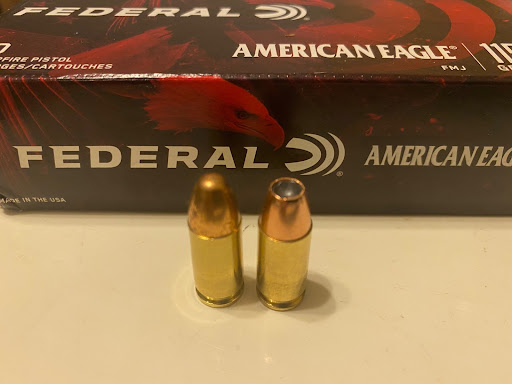
Photo Courtesy of Dinomite
Hollow points and full metal jacket (FMJ) ammo are two of the most common types of bullets in the world. Both of them are better for different applications, but what kind of situations does each thrive in? In this post, we’ll look at the wounds that result from 9mm FMJ vs hollow point ammunition.
FMJ vs Hollow Point Ammo: Comparing Damage From 9mm
When you’re at your local gun store, you’ve probably heard FMJ referred to as “target” or “range” ammo. In contrast, gun store clerks will often refer to hollow points as “self-defense” ammo. Is there any truth behind this, or is it just marketing mumbo-jumbo? My friend Bruce and I hit the range to find the truth. For our experiment, we used Federal American Eagle FMJ and Sig Sauer Elite Defense hollow points. We fired both rounds from my trusty Glock 19.

Federal American Eagle 115 grain FMJ (L), Sig Sauer Elite Defense 124 grain hollow point (R)
The Results
After blasting one pumpkin with FMJ and another with hollow point ammo, we took a look at the damage each round caused. Here’s the results of our experiment.

Exit wounds from a FMJ (left) vs a hollow point (right). You can see that the hollow points deal considerably more damage.
You can see that the exit wound on the hollow point is significantly bigger. That’s because hollow point ammo mushrooms and fragments when it impacts a target. The end result is much more energy imparted into the target. FMJ rounds still transfer some energy, but they’re designed for penetration, so they often pass straight through soft targets.
Learn More About Firearms Technology at SDI
Do you live at the point where firearms and science converge? If you answered “yes,” a future in firearms and gunsmithing may be calling you. SDI can help you take the first steps on that journey. To learn more, check out all of the programs we offer here.


